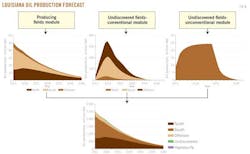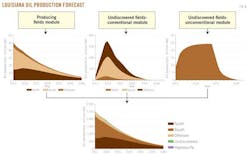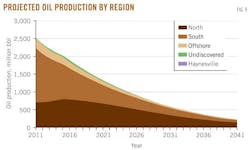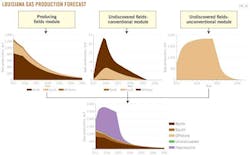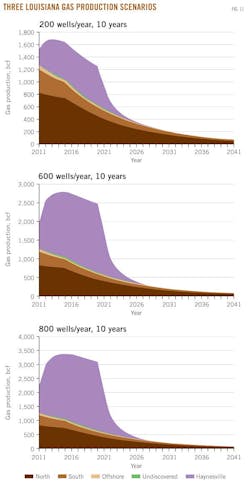P. 5 ~ Continued - How Haynesville shale will lift Louisiana's gas production profile
Producing fields play the dominant role in state production and undiscovered fields are about two orders-of-magnitude smaller in relative terms. Liquids production arising from Haynesville shale gas is negligible. Production decline and capital investment in existing producing fields is the primary determinant of future state production.
Oil production by region is shown in Fig. 9. High oil prices will flatten out the curve and will likely lead to a greater number of new discoveries, as more fields would be expected to be discovered and existing fields will have new wells drilled, but the chance to rebound long term and increase production seems unlikely.
Unless new unconventional plays appear on the horizon, which by some accounts may already be occurring in the Tuscaloosa marine shale and the Smackover brown dolomite, oil production is expected to continue its steady downward decline.
Gas production
Unconventional production is expected to be large and significant and the manner of its development will have a large impact on the fortunes of the state.
Unconventional production is the dominant contributor to state gas output and is expected to remain a significant factor for several decades (Fig. 10). Conventional gas fields in the North still contribute a significant amount to state production but are in decline similar to oil fields. Undiscovered conventional production is not expected to play a large role in future production if historic discovery rates are a reliable guide to future performance.
Under modest assumptions on drilling and recovery rates, gas production in the Haynesville is expected to continue to increase and provide a larger percentage of state production. Three scenarios represent potential production pathways over the next decade (Fig. 11).
Reserves
We estimate remaining reserves from producing fields at 737 million bbl of oil and 15.5 tcf of gas which is slightly larger than EIA estimates described previously. Our estimates of volumes are associated with a probability of 50%, meaning that the actual volume has a 50% chance of being less than the estimate and a 50% chance of exceeding the estimate.
Conventional fields are not expected to contribute a significant amount to total hydrocarbons, and over the next 5 years, 6 million bbl of oil and 204 bcf of gas are expected to be discovered and produced.
In the Haynesville region, if 600 wells/year are drilled on average over the next decade, shale gas is expected to contribute 18.5 tcf, an amount exceeding current conventional gas reserves; if only 200 wells/year are drilled over the next decade, shale gas is expected to contribute 6.2 tcf.
North Louisiana is expected to contribute 87% of total gas production in the state; South Louisiana and offshore 11% and 2%, respectively. For oil reserves, South and North Louisiana are expected to capture 49% and 42% shares, respectively, with offshore contributing 9%.
Displaying 5/6
View Article as Single page
